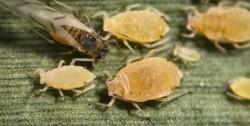 Aphids are commonly a common pest of crops and ornamental plants. Aphids mode of survival relies on having massive amounts of babies to offset the tremendous losses due to predation by other insects and birds. Most of the times, aphis only cause problems when those reach high numbers and the damage to the plant gets to the point of affecting overall plant development. This is known as economic threshold. From time to time, aphis populations adapt and adjust to changes to survive. This is the case of the sugarcane aphid (SCA) that has recently become one of the most important pest of sorghum in Texas and southern US. These aphids originally where found feeding only in sugarcane since their name. By 2013, the sugarcane aphis was found affecting sorghum first in south Texas and then northern parts of Texas, Oklahoma, Louisiana and Mississippi. In many parts of Hopkins County, sorghum is a very important crop, since feral hogs are not as attracted to sorghum as they are to corn.
Aphids are commonly a common pest of crops and ornamental plants. Aphids mode of survival relies on having massive amounts of babies to offset the tremendous losses due to predation by other insects and birds. Most of the times, aphis only cause problems when those reach high numbers and the damage to the plant gets to the point of affecting overall plant development. This is known as economic threshold. From time to time, aphis populations adapt and adjust to changes to survive. This is the case of the sugarcane aphid (SCA) that has recently become one of the most important pest of sorghum in Texas and southern US. These aphids originally where found feeding only in sugarcane since their name. By 2013, the sugarcane aphis was found affecting sorghum first in south Texas and then northern parts of Texas, Oklahoma, Louisiana and Mississippi. In many parts of Hopkins County, sorghum is a very important crop, since feral hogs are not as attracted to sorghum as they are to corn.
This pest can be controlled, but growers must frequently assess infestations to properly time an insecticide if needed, to prevent crop loss and harvest difficulties to honeydew accumulation. The damage to the plants are done by sucking of the plant tissue and accumulation of aphid waste, also known as honeydew because of its sticky feeling similar to honey. Aphids are very small insects. They are hard to see with without magnifying glasses but since they multiply rapidly (remember I explained they have many babies because they have many predators) a population overrun can happen rapidly. Aphids also have the tendency to accumulate in clusters underside the plant leaves. Sugarcane aphids are pale yellow, gray or tan. They have structures on their bodies called cornicles or “tailpipes”, feet and antennae black. Large numbers of aphids can turn a complete plant sticky and shiny. There are other aphids affecting sorghum so call the Hopkins County Extension Office at 903-885-3443 if you suspect aphid infestation in a sorghum crop.








